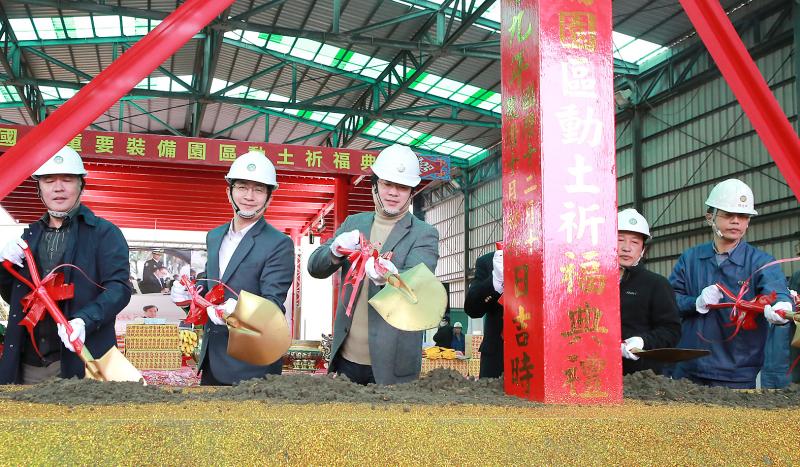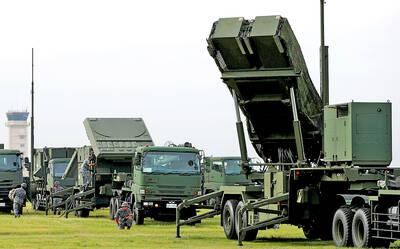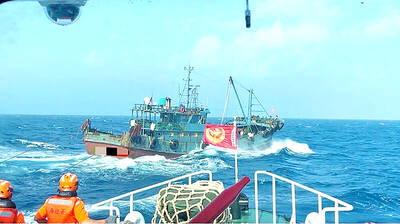It is the legislature’s job to oversee and, if necessary, freeze budgets, Chinese Nationalist Party (KMT) Chairman Johnny Chiang (江啟臣) said yesterday after criticism that Taiwan’s indigenous submarine development was being hindered by legislators calling for funds to be withheld.
Citing concerns over export licenses and blueprint designs, lawmakers from across party lines have pushed for a motion to freeze a portion of the budget for the submarine project, which has been earmarked to receive NT$10.51 billion (US$368.69 million) for construction of a prototype.
KMT Legislator Ma Wen-chun (馬文君) proposed a freeze on NT$5 billion, citing failure to complete procedural requirements before starting a detailed design for the prototype.

Photo: Lin Hsin-han, Taipei Times
KMT Legislator Wen Yu-hsia (溫玉霞) proposed a freeze of NT$2 billion; Chiang (江啟臣) proposed NT$1 billion and KMT Legislator Lu Yu-ling (呂玉玲) proposed NT$20 million.
Democratic Progressive Party (DPP) Legislator Lo Chih-cheng (羅致政) proposed a freeze of NT$1 billion, saying that his proposal was aimed at urging the Ministry of National Defense to obtain Washington’s permissions to allow Taiwan to purchase critical equipment from the US.
Ma, Wen, Chiang and Lu said they doubted that export permits for critical components for construction of the submarines would be granted, while the wait would probably mean that the project would not meet its proposed deadline.
The prototype is scheduled to be launched in 2024 and undergo combat trials for a year before production of a fleet of submarines begins in 2025.
Details of the project have only been discussed at closed-door sessions at the Legislative Yuan, a policy at odds with a transparent budget, Chiang said.
At a meeting on Wednesday last week, Naval Shipbuilding Development Center director Shao Wei-yang (邵維陽) told the legislature that keeping details of the project classified is key to its success and asked that lawmakers approve the project’s funding as had been proposed.
The committee did not reach a decision over the budget and has forwarded the issue to be debated by the legislative caucuses.
Chiang said that the legislature is tasked with overseeing and, if it is deemed necessary, freezing portions of budgets.
The DPP seems to have forgotten this since it took power, he said.
In related news, the Keelung shipyard of CSBC Corp, Taiwan (台灣國際造船) yesterday marked the commencement of manufacturing of vital equipment for naval vessels.
With the exception of critical technology and experienced managers from abroad, CSBC would prioritize employment of Keelung residents and Taiwanese to boost the independence of Taiwan’s defense industry, the company said.
Additional reporting by Weng Yu-huang and Lin Hsin-han

MILITARY BOOST: The procurement was planned after Washington recommended that Taiwan increase its stock of air defense missiles, a defense official said yesterday Taiwan is planning to order an additional four PAC-3 MSE systems and up to 500 missiles in response to an increasing number of missile sites on China’s east coast, a defense official said yesterday. The official, who spoke on condition of anonymity, said that the proposed order would be placed using the defense procurement special budget, adding that about NT$1 trillion (US$32,88 billion) has been allocated for the budget. The proposed acquisition would include launchers, missiles, and a lower tier air and missile defense radar system, they said The procurement was planned after the US military recommended that Taiwan increase

POLITICAL AGENDA: Beijing’s cross-strait Mid-Autumn Festival events are part of a ‘cultural united front’ aimed at promoting unification with Taiwan, academics said Local authorities in China have been inviting Taiwanese to participate in cross-strait Mid-Autumn Festival celebrations centered around ideals of “family and nation,” a move Taiwanese academics said politicizes the holiday to promote the idea of “one family” across the Taiwan Strait. Sources said that China’s Fujian Provincial Government is organizing about 20 cross-strait-themed events in cities including Quanzhou, Nanping, Sanming and Zhangzhou. In Zhangzhou, a festival scheduled for Wednesday is to showcase Minnan-language songs and budaixi (布袋戲) glove puppetry to highlight cultural similarities between Taiwan and the region. Elsewhere, Jiangsu Province is hosting more than 10 similar celebrations in Taizhou, Changzhou, Suzhou,

COGNITIVE WARFARE: Chinese fishing boats transmitting fake identification signals are meant to test Taiwan’s responses to different kinds of perceived incursions, a report said Chinese vessels are transmitting fake signals in Taiwan’s waters as a form of cognitive warfare, testing Taipei’s responses to various types of incursions, a report by the Institute for the Study of War said on Friday. Several Chinese fishing vessels transmitted fake automatic identification system (AIS) signals in Taiwan’s waters last month, with one mimicking a Russian warship and another impersonating a Chinese law enforcement vessel, the report said. Citing data from Starboard Maritime Intelligence, the report said that throughout August and last month, the Chinese fishing boat Minshiyu 06718 (閩獅漁06718) sailed through the Taiwan Strait while intermittently transmitting its own AIS

CHINESE INFILTRATION: Medical logistics is a lifeline during wartime and the reported CCP links of a major logistics company present a national security threat, an expert said The government would bolster its security check system to prevent China from infiltrating the nation’s medical cold chain, a national security official said yesterday. The official, who wished to stay anonymous, made the remarks after the Chinese-language magazine Mirror Media (鏡周刊) reported that Pharma Logistics (嘉里醫藥物流) is in charge of the medical logistics of about half of the nation’s major hospitals, including National Taiwan University Hospital and Taipei Veterans General Hospital. The company’s parent, Kerry TJ Logistics Co (嘉里大榮物流), is associated with the National Committee of the Chinese People’s Political Consultative Conference (CPPCC) and the Chinese People’s Liberation Army (PLA), the